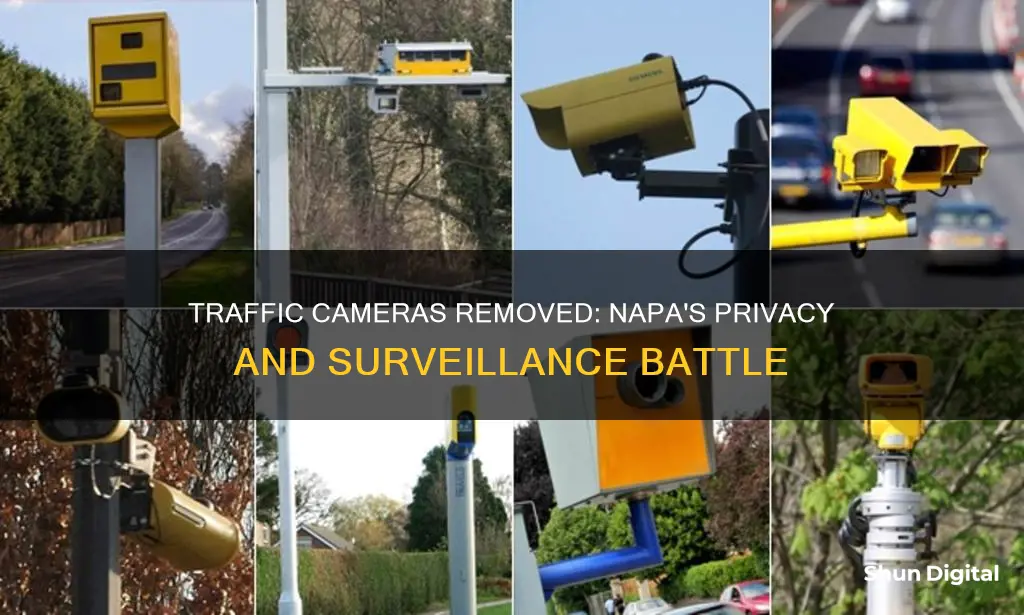
Traffic cameras have been a topic of discussion in Napa, California, with the city considering whether to bring back the once-controversial red-light camera enforcement system. The cameras were removed from Napa's intersections in 2017, and since then, the city has been exploring ways to improve traffic safety. While some councilmembers support the idea of reinstating the cameras as a way to reduce accidents, others argue that the high fines associated with the cameras can be a significant burden for some residents. With mixed opinions on the effectiveness and impact of the cameras, the city of Napa is weighing the benefits of improved safety against potential detriments and community concerns.
| Characteristics | Values |
|---|---|
| Reason for removal | The City Council decided not to renew the Redflex contract, despite a recommendation to do so from the Napa Police Department. |
| Date of removal | 2017 |
| Date of introduction | 2008 |
| Company | Redflex Traffic Systems |
| Contract | Australia-based |
| Fines | $500 |
| Company scandals | Bribery scandals in Chicago and Columbus, Ohio |
| Company settlement | $20 million to Chicago |
| Accidents | 90% of collisions occurred at intersections |
| Accident ranking | Napa ranked 9th highest out of 105 comparable jurisdictions in total fatal and injury crashes |
| Accident ranking (composite crashes) | 5th highest |
| Accident ranking (2019) | Napa County was the sixth worst of 105 comparable jurisdictions in total fatal and injury crashes |
| Accident ranking (2019, composite crashes) | Second worst |
What You'll Learn

The previous red-light camera system was discontinued in 2017
The red-light camera system in Napa, California, was discontinued in 2017. The system was first approved by the City Council in 2008 through a contract with Australia-based Redflex Traffic Systems. However, in 2017, the City Council decided not to renew the contract with Redflex, marking the end of the red-light camera system in the city.
The decision to discontinue the program came eight years after the cameras began appearing at local intersections. While the Napa Police Department recommended renewing the contract, the City Council, including former supporter and then-councilmember Peter Mott, decided against it. Mott stated that he didn't think the benefits of the system outweighed the drawbacks. One of the main concerns was the nearly $500 fine for violations, which many saw as too high and detrimental, especially for those living paycheck to paycheck.
In addition to the high cost of fines, there were also ethical concerns surrounding the red-light camera system. Redflex, the company providing the technology, had been implicated in bribery scandals in Chicago and Columbus, Ohio, resulting in prison sentences for both city and company officials. The company eventually settled a lawsuit with Chicago for $20 million over admitted fraud.
The red-light camera system in Napa faced opposition and was discontinued due to a combination of factors, including the high cost of fines, ethical concerns surrounding the vendor, and a reevaluation of the system's benefits versus its drawbacks.
Displaying Car Camera Feeds on Tablets: Easy Guide
You may want to see also

The system was considered controversial due to high fines
The red-light camera system in Napa, California, was considered controversial due to the high fines imposed on violators. The fine for going through a red light or turning right on a red arrow was set at $445, while failing to stop on a right turn carried a $217 fine. These fines were seen as excessive and a source of community consternation, especially for low-income individuals who might struggle to pay them.
The high fines were a significant factor in the decision to discontinue the red-light camera program in 2017. Then-councilmember Jill Techel, who had initially voted against the program in 2008, cited the financial burden on motorists as a reason for her opposition. She expressed concern that the program would result in an excessive number of tickets for low-risk traffic violations, with a $500 fine being a substantial penalty for many residents.
The potential for revenue generation from these fines was also a point of contention. While some councilmembers acknowledged that the fees could help cover the expenses of the program and fund traffic safety education, others criticized the potential for the cameras to be abused as profit centers. The high volume of tickets issued by the automated system, combined with the lack of progressivity in the fine amount, contributed to the perception that the program was more about generating revenue than improving traffic safety.
Additionally, the company operating the red-light cameras, Redflex Traffic Systems, faced bribery scandals in other cities, resulting in prison sentences for both city and company officials. This further eroded trust in the system and raised questions about the integrity of the program.
The controversy surrounding the high fines and other issues led to the decision to discontinue the red-light camera program in Napa, with the City Council choosing not to renew the contract with Redflex Traffic Systems in 2017.
Are PTZ Cameras Electrically Charged?
You may want to see also

The system was associated with bribery scandals
The red-light camera traffic enforcement system in Napa, California, has been mired in controversy since its introduction in 2008. The system, contracted with Australia-based Redflex Traffic Systems, was intended to improve traffic safety by reducing intersection-related accidents. However, it faced strong opposition from the community due to the high cost of fines and concerns about its effectiveness.
In 2017, the Napa City Council decided not to renew the contract with Redflex, despite recommendations from the Napa Police Department. This decision was influenced by the growing detriments associated with the system, including community consternation over the nearly $500 fines that were issued for violations. Additionally, Redflex had become embroiled in bribery and corruption scandals in Chicago and Columbus, Ohio, resulting in prison sentences for both city and company officials. The company was found guilty of admitted fraud and agreed to pay a $20 million settlement to the city of Chicago.
The bribery scandals involving Redflex Traffic Systems raised serious concerns about the integrity and ethics of the red-light camera system in Napa. The scandals exposed a pattern of corruption and illegal activities within the company, calling into question the fairness and legitimacy of the traffic enforcement program. The scandals also brought to light the potential for abuse of power and the prioritization of profit over public safety.
The decision to not renew the contract with Redflex was influenced by the community's loss of faith in the system's effectiveness and the growing concerns over the high cost of fines. The bribery scandals further tarnished the reputation of the program and likely contributed to the council's decision to discontinue it. It is important to note that the presence of bribery and corruption does not necessarily indicate that the system itself was ineffective in improving traffic safety. However, the scandals undoubtedly played a role in shaping public perception and the ultimate fate of the red-light camera traffic enforcement system in Napa.
While the system was intended to enhance road safety, the bribery scandals associated with Redflex Traffic Systems highlighted the potential pitfalls of privatizing traffic enforcement and the need for stringent ethical standards and oversight in such partnerships. The experience in Napa serves as a cautionary tale for other communities considering similar initiatives, underscoring the importance of transparency, accountability, and community engagement in traffic safety programs.
Clarity in Camera Raw: Enhancing Image Details
You may want to see also

The system reduced accidents at major intersections
The city of Napa, California, has been considering reinstating red-light cameras at major intersections to improve road safety. The idea has been met with mixed reactions from the community and council members. However, data suggests that the system reduced accidents at major intersections.
Napa has a history of intersection-related traffic accidents, which pose safety risks for residents, businesses, and visitors. Between 2016 and 2020, 90% of total collisions in the city occurred at intersections. Napa ranked 9th highest out of 105 comparable jurisdictions in California for fatal and injury crashes and 5th highest for composite crashes.
In 2008, the Napa City Council approved a red-light camera system, which was in place until 2017. During that time, the system effectively reduced accidents at Napa's major intersections. Mayor Scott Sedgley, the only council member who supported renewing the contract in 2017, received a ticket himself and noticed a change in his behavior. He stated that he now slows down when approaching yellow lights to avoid an expensive ticket, which he believes is a positive change.
In addition to Mayor Sedgley's personal experience, statistical data supports the effectiveness of red-light cameras in reducing accidents. According to the Insurance Institute for Highway Safety (IIHS), cities with red-light camera enforcement programs have seen significant reductions in injury crashes at intersections. For example, Oxnard, California, experienced a 29% reduction in injury crashes after introducing red-light cameras. Historically, large cities with red-light enforcement programs have achieved a 21% reduction in fatal red-light running crash rates. Conversely, studies show that discontinuing red-light safety programs can lead to an increase of up to 30% in fatal red-light running crash rates.
While the system has proven effective in reducing accidents, it has also faced criticism and concerns. Some community members and council members expressed dismay over the high fines of approximately $500, which can be a significant financial burden, especially for those living paycheck to paycheck. There have also been concerns about the revenue generation aspect of the program, with critics arguing that the fees should primarily cover expenses and traffic safety education rather than being treated as a profit center. Additionally, the company operating the cameras, Redflex Traffic Systems, was embroiled in bribery scandals that resulted in prison sentences for city and company officials.
Despite the mixed reactions, the statistical evidence and personal testimonies suggest that the red-light camera system in Napa contributed to a reduction in accidents at major intersections. The city is now reconsidering reinstating the system to address ongoing traffic safety concerns and improve road safety for its residents, businesses, and visitors.
Charging Exilim Cameras: A Quick Guide
You may want to see also

The system was considered ineffective at improving overall safety
The red-light camera system in Napa, California, was discontinued in 2017 due to a range of factors, including community backlash, concerns about the cost of fines, and the system's limited effectiveness in improving overall safety. While some supported the system's reintroduction in 2023, others argued that it was ineffective and did not address the underlying issues contributing to traffic accidents.
The system's ineffectiveness was a significant factor in its discontinuation. Despite the presence of red-light cameras at four intersections, community members and councilmembers expressed concerns about the lack of noticeable improvements in traffic safety. The cameras were intended to reduce intersection-related accidents, but their impact on accident rates was mixed. While some argued that the cameras reduced accidents at major intersections, others pointed out that they could also increase accidents by encouraging drivers to speed up when the light turned yellow to avoid being caught by the camera. This practice can lead to more dangerous situations and collisions.
Another concern was the volume of tickets generated by the system, which was higher than traditional human enforcement methods. This high volume, combined with the significant cost of fines, resulted in community consternation. Many felt that the $500 fines were excessive and could pose a significant financial burden, particularly for those living paycheck to paycheck. The lack of flexibility in fine amounts meant that a $500 ticket would have a much more significant impact on lower-income individuals than on those with higher incomes.
Furthermore, there were also concerns about the motives behind the system. Some community members and councilmembers argued that the cameras were used as profit centers, with the city benefiting from the revenue generated by the fines. This perception further contributed to the negative perception of the system and raised questions about the city's priorities.
In addition to the concerns about fines and revenue, the red-light camera system faced criticism for its limited scope. While the cameras were installed at four intersections, they did not address the underlying issues contributing to traffic accidents in other areas of the city. Community members advocated for more comprehensive solutions, such as improved roadway design, better traffic light timing, and the implementation of traffic-calming measures such as roundabouts and narrowed streets. These measures were seen as more effective in improving overall safety and reducing accidents, rather than solely focusing on red-light violations.
In conclusion, the red-light camera system in Napa was considered ineffective at improving overall safety due to its mixed impact on accident rates, the high volume of tickets and costly fines, and its failure to address the underlying causes of traffic accidents. As a result, the system was discontinued, and the city explored alternative approaches to enhance traffic safety and reduce accidents.
Traffic Cameras on Route 146: Are Motorists Being Watched?
You may want to see also
Frequently asked questions
The traffic cameras in Napa were removed in 2017 when the City Council decided not to renew the contract with Redflex Traffic Systems, the company that provided the cameras.
There were several reasons for the removal of the traffic cameras in Napa. One of the main reasons was the high cost of fines for violations, which was seen as a detriment to the community. There were also concerns about the effectiveness of the system in improving traffic safety, with some arguing that the system targeted motorists committing low-risk traffic violations. Additionally, Redflex Traffic Systems was involved in bribery scandals, resulting in a loss of trust in the company.
The traffic cameras were intended to improve traffic safety by reducing accidents at major intersections. The system was designed to target repeat offenders and encourage drivers to be more cautious when approaching yellow lights.
Yes, as of 2023, the Napa City Council is reconsidering the implementation of red-light camera traffic enforcement. This decision comes amid community calls to improve traffic safety in the city. However, the plan for reinstating the cameras is still being examined, and there are mixed opinions among residents and councilmembers.







